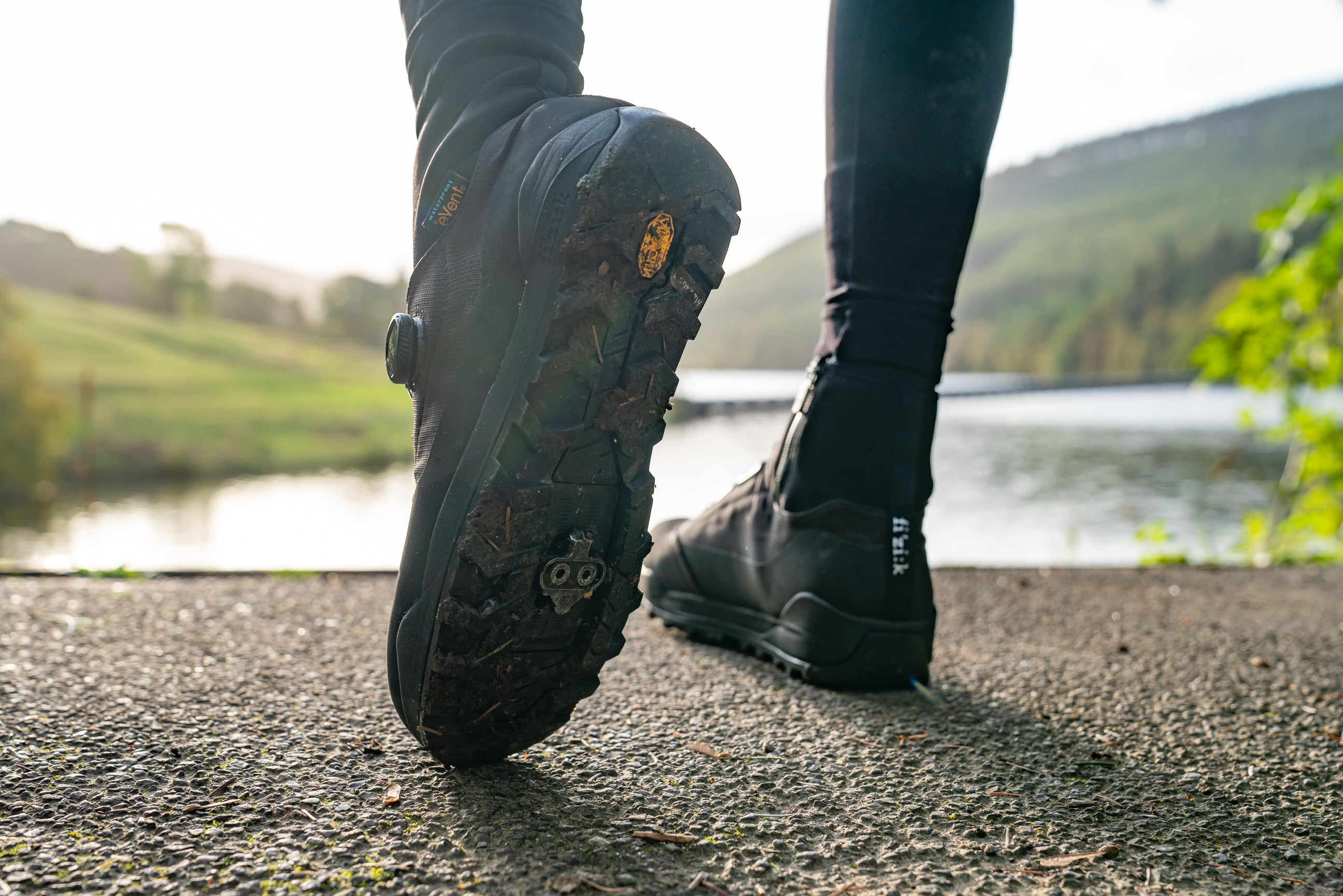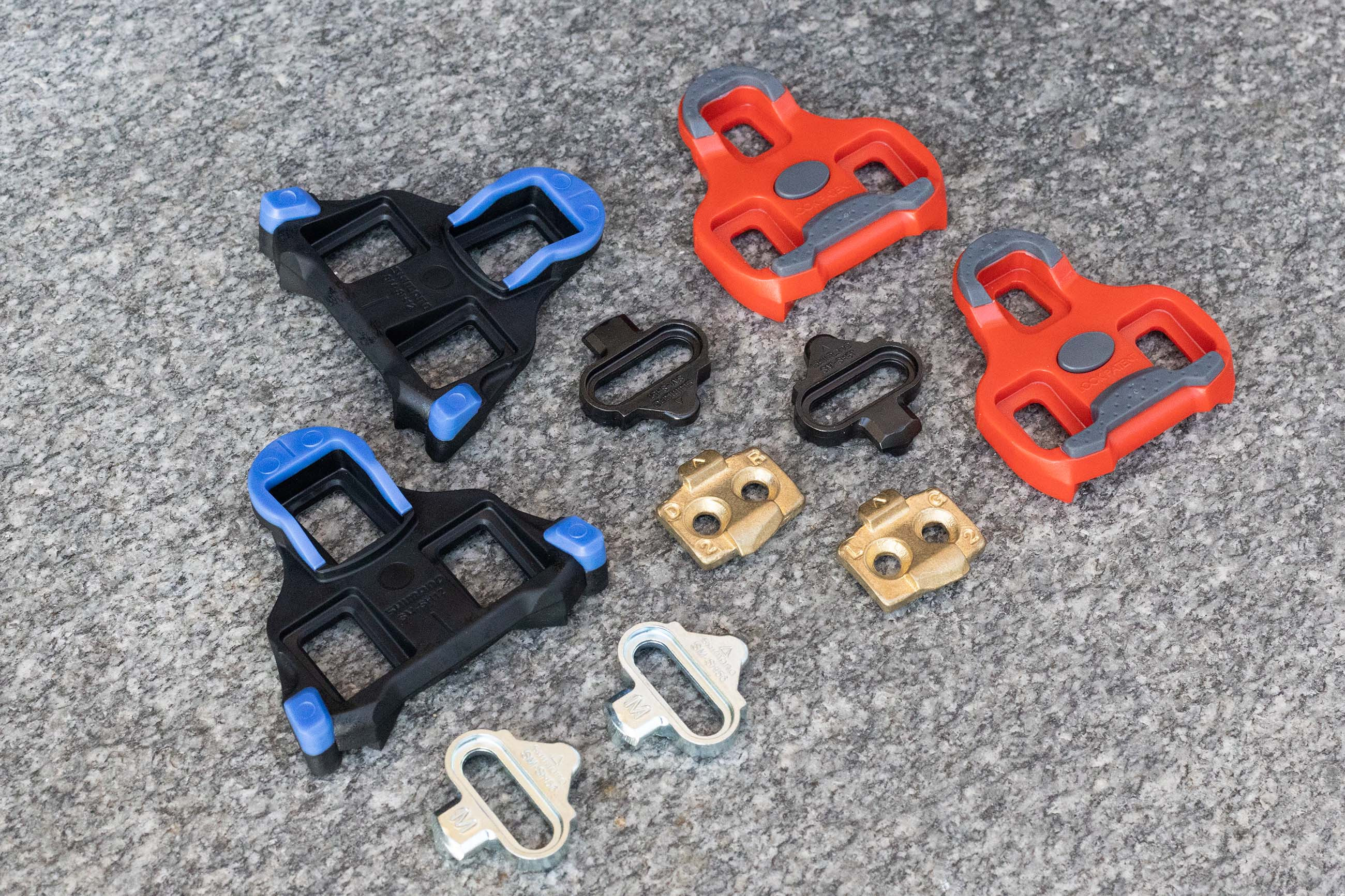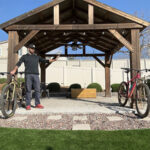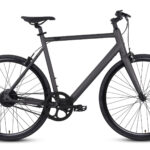Can I Use Spd Pedals On A Road Bike? Absolutely! SPD (Shimano Pedaling Dynamics) pedals, primarily known for mountain biking and gravel riding, can indeed be a viable and comfortable choice for road cycling. This article on usabikers.net dives into the benefits, considerations, and potential drawbacks of using SPD pedals on your road bike, ensuring you make an informed decision. Explore topics like pedal efficiency, cleat compatibility, and the overall biking experience. Let’s gear up and explore the world of road biking with SPDs, enhancing your cycling adventures and biker lifestyle.
1. Understanding SPD and SPD-SL Pedals
Shimano’s SPD and SPD-SL clipless pedals are popular choices for cyclists, but what exactly sets them apart? SPD, or Shimano Pedaling Dynamics, is a system widely used for mountain biking, gravel riding, and even some road cycling applications. SPD-SL (SuperLight) is mainly used for road cycling. It’s important to understand the differences between these two systems to determine the best fit for your riding style.
1.1. Key Differences Between SPD and SPD-SL
What are the major distinctions between SPD and SPD-SL pedals?
| Feature | SPD | SPD-SL |
|---|---|---|
| Intended Use | Mountain biking, gravel riding, touring, commuting | Road cycling |
| Cleat Material | Metal | Plastic |
| Cleat Size | Smaller | Larger |
| Bolt System | Two-bolt | Three-bolt |
| Entry | Double-sided | Single-sided |
| Walkability | Easier, recessed cleat | Difficult, exposed cleat |
| Mud Shedding | Excellent | Poor |
| Weight | Generally heavier | Generally lighter |
| Contact Area | Smaller | Larger |
| Adjustability | Less adjustability | More adjustability |
Source: Expert reviews from usabikers.net and Shimano product specifications
Understanding these differences will help you determine if SPD pedals are a suitable choice for your road bike.
1.2. A Brief History of Clipless Pedals
How did clipless pedals evolve, and where do SPD and SPD-SL fit in?
The concept of clipless pedals was first developed by Look, a French brand initially known for ski bindings. In 1984, Bernard Hinault, a five-time Tour de France winner, used Look’s clipless pedal system, marking a significant shift in cycling technology.
Shimano entered the clipless pedal market in 1987 with the Dura-Ace 7401, which used a Look-compatible cleat under license. The SPD design, featuring a smaller metal cleat with two points of attachment, was first released in 1990. This design was well-suited for mountain biking but wasn’t ideal for high-performance road cycling, where pedaling efficiency is paramount. It wasn’t until 2003 that Shimano launched the SPD-SL, developed with input from Lance Armstrong, specifically designed for road cycling. Source: Shimano product history and interviews.
2. Advantages of Using SPD Pedals on a Road Bike
What are the benefits of choosing SPD pedals for your road bike?
While SPD-SL pedals are traditionally favored for road bikes, SPD pedals offer several compelling advantages.
2.1. Double-Sided Entry for Convenience
How does double-sided entry simplify your ride?
Most SPD pedals feature a double-sided design, allowing you to clip in from either side. This is a major advantage when starting from a standstill, especially in busy urban environments or on challenging terrains. The convenience of not having to look down to find the correct side of the pedal can save valuable time and reduce frustration, making your ride smoother and more enjoyable.
2.2. Walkable Cleats for Versatility
Why are walkable cleats a game-changer for road cyclists?
 Shimano SPD cleats on walkable shoes
Shimano SPD cleats on walkable shoes
The primary advantage of SPD cleats is their walkability. SPD cleats are smaller and recessed into the sole of the shoe, allowing you to walk comfortably without the awkward waddle associated with SPD-SL cleats. This is particularly useful for:
- Commuting: Navigating traffic lights and walking to bike racks.
- Touring: Exploring towns and attractions during breaks.
- Everyday Riding: Running errands or stopping for coffee.
2.3. Mud-Shedding Design for All-Weather Performance
How does the mud-shedding design enhance your road cycling experience?
SPD pedals are designed with an open construction that effectively sheds mud and debris. This is particularly beneficial if you ride in wet or challenging conditions, ensuring consistent engagement and performance.
2.4. Enhanced Comfort for Long Rides
Can SPD pedals improve your comfort on extended road bike adventures?
 Two-bolt cleats offer a range of fore and aft adjustments
Two-bolt cleats offer a range of fore and aft adjustments
SPD shoes often feature a more flexible sole compared to the stiff carbon soles of high-end road cycling shoes. This flexibility can enhance comfort on longer rides, reducing foot fatigue and making the overall experience more enjoyable. According to a study by the American Journal of Sports Medicine, flexible-soled shoes can decrease plantar pressure, contributing to greater comfort during physical activity.
2.5. Versatility Across Different Bikes
What are the benefits of using SPD pedals across multiple bikes?
If you own multiple bikes, such as a road bike, a mountain bike, and a gravel bike, using SPD pedals allows you to use the same pair of shoes for all your rides. This can save you money and simplify your cycling setup.
3. Potential Drawbacks of SPD Pedals on a Road Bike
What are the possible downsides of using SPD pedals for road cycling?
While SPD pedals offer several advantages, it’s important to be aware of their potential drawbacks on a road bike.
3.1. Smaller Contact Area and Power Transfer
How does a smaller contact area affect power transfer?
SPD pedals have a smaller contact area between the cleat and the pedal compared to SPD-SL pedals. This can result in less efficient power transfer, particularly during high-intensity efforts such as sprinting or climbing. Professional cyclists and performance-oriented riders may find this a significant disadvantage.
3.2. Reduced Stiffness and Efficiency
Can the flexibility of SPD shoes impact your pedaling efficiency?
SPD shoes often have more flexible soles than SPD-SL shoes, which can reduce pedaling stiffness and efficiency. This is because more energy is absorbed by the flexing of the shoe rather than being transferred directly to the pedals.
3.3. Weight Considerations
Are SPD pedals heavier than SPD-SL pedals?
In general, SPD pedals tend to be slightly heavier than comparable SPD-SL models. While the weight difference may not be significant for casual riders, it can be a consideration for those seeking to minimize weight for competitive purposes.
3.4. Aesthetics and Tradition
Do SPD pedals fit the traditional road bike aesthetic?
Some cyclists prefer the sleek and minimalist look of SPD-SL pedals on a road bike. SPD pedals, with their more rugged appearance, may not appeal to those who prioritize aesthetics and tradition.
4. Who Should Consider SPD Pedals on a Road Bike?
Who are the ideal candidates for using SPD pedals on their road bikes?
SPD pedals can be a great choice for certain types of road cyclists.
4.1. Commuters and Urban Riders
Why are SPD pedals ideal for commuting and urban riding?
Commuters and urban riders who frequently stop and start, navigate traffic, and walk in their cycling shoes will appreciate the convenience and walkability of SPD pedals.
4.2. Touring and Adventure Cyclists
How do SPD pedals enhance touring and adventure cycling experiences?
Touring and adventure cyclists who prioritize comfort and versatility will find SPD pedals to be an excellent option. The ability to walk comfortably and the durability of SPD cleats make them well-suited for long-distance rides and varied terrain.
4.3. Casual and Recreational Riders
Why are SPD pedals a good choice for casual and recreational road cyclists?
Casual and recreational riders who value comfort and ease of use over pure performance may prefer SPD pedals. The double-sided entry and walkable cleats make for a more relaxed and enjoyable riding experience.
4.4. Cyclists with Multiple Bikes
What are the advantages of using SPD pedals for cyclists with multiple bikes?
Cyclists who own multiple bikes, such as a road bike, mountain bike, and gravel bike, can benefit from the versatility of SPD pedals. Using the same shoes for all bikes simplifies their cycling setup and saves money.
5. How to Set Up SPD Pedals on Your Road Bike
What do you need to know to properly set up SPD pedals on your road bike?
If you decide to use SPD pedals on your road bike, proper setup is essential to ensure comfort, efficiency, and safety.
5.1. Choosing the Right SPD Pedals and Shoes
How do you select the best SPD pedals and shoes for road cycling?
Select SPD pedals that are compatible with road cycling. Look for lightweight models with a decent platform for power transfer. When choosing shoes, consider models with a moderately stiff sole for efficiency and a comfortable fit for long rides.
5.2. Installing SPD Cleats
What is the correct way to install SPD cleats on your shoes?
Follow these steps to install SPD cleats:
- Loosen the cleat bolts.
- Position the cleat on the sole of the shoe.
- Align the cleat with the ball of your foot.
- Tighten the bolts securely.
- Test the cleat position and adjust as needed.
5.3. Adjusting Cleat Position for Optimal Performance
How do you fine-tune cleat position for comfort and efficiency?
Experiment with cleat position to find the optimal setup for your biomechanics. Adjust the cleat forward or backward to optimize power transfer and reduce stress on your knees and ankles. Most cleats offer some float, allowing your feet to rotate slightly, which can improve comfort and prevent injuries.
5.4. Setting Pedal Tension
What is the right pedal tension for your riding style and experience?
Adjust the pedal tension to your preference. Beginners may prefer a lower tension for easier release, while experienced riders may opt for higher tension for a more secure connection.
6. Alternatives to SPD and SPD-SL Pedals
What other clipless pedal systems are available for road cycling?
While SPD and SPD-SL are popular choices, several alternative clipless pedal systems are available.
6.1. Look Keo Pedals
How do Look Keo pedals compare to SPD-SL pedals?
 Look Keo pedals
Look Keo pedals
Look Keo pedals are a popular alternative to SPD-SL pedals, offering a large platform and secure cleat engagement. Look Keo cleats are also available in different float options, allowing you to customize the feel of your connection to the bike. However, they are incompatible with SPD-SL cleats.
6.2. Time Pedals
What are the key features of Time pedals for road cycling?
Time pedals are known for their ergonomic design and angular float, which allows your feet to move naturally during the pedal stroke. Time cleats are not compatible with SPD-SL or Look Keo pedals.
6.3. Wahoo Speedplay Pedals
Why are Wahoo Speedplay pedals a unique option for road cyclists?
 Wahoo Speedplay Zero pedals
Wahoo Speedplay Zero pedals
Wahoo Speedplay pedals feature a unique lollipop-shaped design with a cleat that attaches to the shoe with four bolts. Speedplay pedals offer exceptional adjustability and float, making them a favorite among cyclists with specific biomechanical needs. They require an adapter to be fixed to three-bolt shoes, or some shoes are available with four fixing points for in-built Speedplay compatibility.
6.4. Crankbrothers Pedals
What makes Crankbrothers pedals a distinctive choice?
Crankbrothers pedals, known for their mountain bike applications, also offer road-specific models. These pedals feature a four-sided entry system, making them easy to clip into.
7. Maintaining Your SPD Pedals and Cleats
How do you keep your SPD pedals and cleats in top condition?
Proper maintenance is essential to ensure the longevity and performance of your SPD pedals and cleats.
7.1. Cleaning and Lubrication
How often should you clean and lubricate your SPD pedals?
Clean your SPD pedals regularly with a brush and degreaser to remove dirt and grime. Lubricate the moving parts with a light oil or grease to keep them functioning smoothly.
7.2. Checking for Wear and Tear
What signs of wear and tear should you look for on your SPD pedals and cleats?
Inspect your SPD pedals and cleats regularly for signs of wear and tear. Replace worn cleats to maintain secure engagement and prevent accidents.
7.3. Replacing Cleats When Necessary
When should you replace your SPD cleats?
Replace your SPD cleats when they show signs of significant wear, such as rounded edges or difficulty clipping in and out.
8. Expert Opinions on Using SPD Pedals for Road Biking
What do cycling experts say about using SPD pedals on road bikes?
Cycling experts offer varied perspectives on using SPD pedals for road biking.
8.1. Professional Cyclists
What are the views of professional cyclists on SPD pedals for road biking?
Professional cyclists typically prefer SPD-SL pedals for their superior power transfer and efficiency. However, some may use SPD pedals for training rides or commuting.
8.2. Cycling Coaches
What advice do cycling coaches offer regarding SPD pedals on road bikes?
Cycling coaches generally recommend SPD-SL pedals for serious road cyclists focused on performance. However, they may suggest SPD pedals for beginners, commuters, or those with specific comfort needs.
8.3. Bike Mechanics
What insights do bike mechanics provide on SPD pedals for road biking?
Bike mechanics often see SPD pedals as a versatile and durable option for road cycling. They appreciate their ease of maintenance and compatibility with a wide range of shoes.
9. Real-World Experiences: Cyclists Sharing Their Stories
What do real cyclists say about their experiences with SPD pedals on road bikes?
Hearing from cyclists who have used SPD pedals on road bikes can provide valuable insights.
9.1. Commuters
How do commuters find SPD pedals for their daily rides?
Many commuters praise SPD pedals for their convenience and walkability. They appreciate the ability to wear comfortable shoes and easily clip in and out in traffic.
9.2. Touring Cyclists
What do touring cyclists say about using SPD pedals on long-distance rides?
Touring cyclists often prefer SPD pedals for their comfort and durability. They value the ability to walk comfortably during breaks and explore towns and attractions.
9.3. Recreational Riders
How do recreational riders enjoy SPD pedals on their road bikes?
Recreational riders often find SPD pedals to be a great option for their relaxed riding style. They appreciate the ease of use and comfort they provide.
10. Conclusion: Making the Right Choice for Your Road Bike
What is the final verdict on using SPD pedals on a road bike?
Ultimately, the decision of whether to use SPD pedals on a road bike depends on your individual needs and preferences. If you prioritize comfort, convenience, and versatility, SPD pedals can be an excellent choice. However, if you are a serious road cyclist focused on maximizing performance, SPD-SL pedals may be a better option.
Remember to consider the advantages and disadvantages of each system, and choose the one that best suits your riding style and goals. Visit usabikers.net for more information, reviews, and community discussions to help you make the right choice for your cycling adventures.
FAQ: Your Questions About SPD Pedals on Road Bikes Answered
1. Can I use mountain bike shoes with SPD pedals on a road bike?
Yes, you can use mountain bike shoes with SPD pedals on a road bike. Mountain bike shoes are designed to be compatible with SPD cleats, making them a versatile option for road cycling.
2. Are SPD cleats compatible with SPD-SL pedals?
No, SPD cleats are not compatible with SPD-SL pedals. SPD and SPD-SL use different cleat designs and attachment systems.
3. Will SPD pedals damage my road bike shoes?
No, SPD pedals will not damage your road bike shoes, provided that the shoes are designed to be compatible with SPD cleats.
4. Can I adjust the release tension on SPD pedals?
Yes, you can adjust the release tension on SPD pedals. Most SPD pedals have an adjustment screw that allows you to increase or decrease the tension required to clip in and out.
5. Are SPD pedals suitable for long-distance road cycling?
SPD pedals can be suitable for long-distance road cycling, particularly for cyclists who prioritize comfort and versatility over pure performance.
6. How often should I replace my SPD cleats?
You should replace your SPD cleats when they show signs of significant wear, such as rounded edges or difficulty clipping in and out.
7. Can I use SPD pedals for racing?
While SPD pedals can be used for racing, serious road cyclists focused on maximizing performance typically prefer SPD-SL pedals for their superior power transfer and efficiency.
8. Are SPD pedals more durable than SPD-SL pedals?
SPD pedals are generally considered to be more durable than SPD-SL pedals due to their metal cleat construction.
9. Can I walk comfortably in SPD shoes?
Yes, you can walk comfortably in SPD shoes. SPD cleats are recessed into the sole of the shoe, allowing you to walk without the awkward waddle associated with SPD-SL cleats.
10. Where can I find the best SPD pedals and shoes for road biking?
You can find the best SPD pedals and shoes for road biking at usabikers.net, which offers a wide selection of products, reviews, and expert advice to help you make the right choice.
Ready to take your road biking experience to the next level? Explore usabikers.net today for in-depth articles, product reviews, and a thriving community of fellow motorcycle and cycling enthusiasts. Whether you’re seeking gear recommendations, maintenance tips, or simply a place to share your passion, usabikers.net is your ultimate resource. Join us now and discover the world of road biking and biker lifestyle!
Address: 801 Sturgis Main St, Sturgis, SD 57785, United States
Phone: +1 (605) 347-2000
Website: usabikers.net


